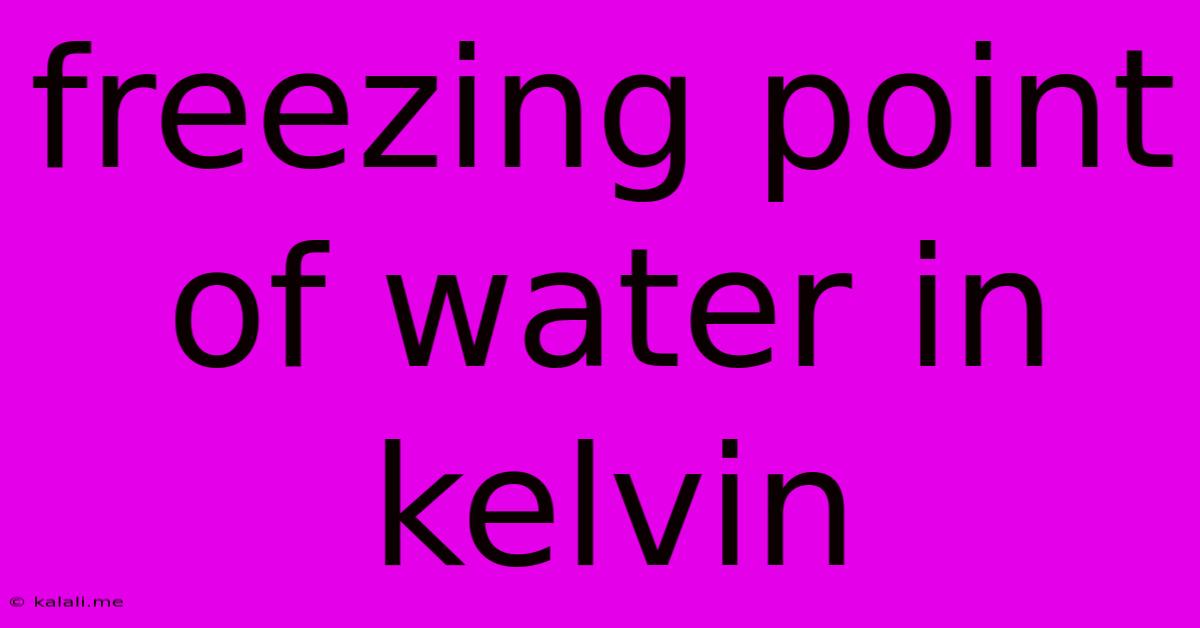Freezing Point Of Water In Kelvin
Kalali
May 25, 2025 · 2 min read

Table of Contents
The Freezing Point of Water in Kelvin: A Deep Dive
The freezing point of water is a fundamental concept in science, crucial for understanding various physical and chemical processes. While many are familiar with the Celsius and Fahrenheit scales, understanding the freezing point of water in Kelvin is essential for accurate scientific calculations and a deeper grasp of thermodynamics. This article will explore the freezing point of water in Kelvin, its significance, and related concepts. This is a crucial topic for students, scientists, and anyone interested in the properties of water and temperature scales.
What is Kelvin?
The Kelvin scale, also known as the absolute temperature scale, is a thermodynamic temperature scale where zero Kelvin (0 K) represents absolute zero – the theoretical absence of all thermal energy. Unlike Celsius and Fahrenheit, which are relative scales with arbitrary zero points, Kelvin is an absolute scale. This means that there are no negative values on the Kelvin scale. This absolute zero point is incredibly important in various scientific applications and calculations.
Freezing Point of Water in Different Scales
Before delving into the Kelvin value, let's quickly review the freezing point of water in other common scales:
- Celsius (°C): 0°C
- Fahrenheit (°F): 32°F
- Kelvin (K): 273.15 K
The Freezing Point of Water in Kelvin: 273.15 K
The freezing point of water in Kelvin is 273.15 K. This value is derived from the relationship between the Kelvin and Celsius scales: K = °C + 273.15. Therefore, converting the Celsius freezing point of 0°C to Kelvin gives us 273.15 K. This precise value is important for accurate scientific measurements and calculations.
Why is the Kelvin Scale Important?
The Kelvin scale's importance stems from its absolute nature. Many physical laws and equations, particularly those involving gas laws and thermodynamics, are expressed most simply and accurately using Kelvin. For instance, the ideal gas law, which describes the behavior of gases, requires temperature to be expressed in Kelvin. Using Celsius or Fahrenheit would lead to inaccurate predictions.
Practical Applications:
Understanding the freezing point of water in Kelvin has several practical applications across various scientific fields, including:
- Cryogenics: The study of materials at extremely low temperatures often utilizes the Kelvin scale.
- Material Science: The properties of many materials change significantly at different temperatures, and using the Kelvin scale ensures precise analysis.
- Chemistry: Many chemical reactions are temperature-dependent, and using Kelvin ensures accurate calculations and experimental results.
- Meteorology: While weather reports generally use Celsius or Fahrenheit, Kelvin is essential for sophisticated atmospheric modeling.
Conclusion:
The freezing point of water in Kelvin, 273.15 K, is a cornerstone of scientific understanding. The absolute nature of the Kelvin scale makes it indispensable for accurate and precise measurements and calculations across a wide range of scientific disciplines. Understanding this value provides a more complete understanding of thermodynamics and the properties of water. Remember this fundamental constant as you continue your scientific explorations!
Latest Posts
Latest Posts
-
The Kingdom Of Heaven Suffers Violence
May 25, 2025
-
How To List Internship At Same Company Twice Resume
May 25, 2025
-
How To Know If Battery Is Dead
May 25, 2025
-
Revenge Is Best Served As A Cold Dish
May 25, 2025
-
What Does It Mean To Be Poor In Spirit
May 25, 2025
Related Post
Thank you for visiting our website which covers about Freezing Point Of Water In Kelvin . We hope the information provided has been useful to you. Feel free to contact us if you have any questions or need further assistance. See you next time and don't miss to bookmark.